But is art confined to being the result of an act of creation? I asked myself this question today, as I contemplated a chess study - the 1951 work of a true genius, Vladimir Korolkov, a russian chess composer of the past century. I am fully aware that the idea that a chess study can be a work of art is controversial already per se, and am prepared to defend it here, by showing the clear artistic elements in the composition. But after I'm done with persuading you that what we are looking at is a piece of art, I will have a different argument to propose, the one I hinted at the beginning of this paragraph.
So let us see what the chess study is, and what are its clear artistic elements. The study, which won the first prize at the Lelo tournament in 1951, is shown below. White is to move and win (diagram 1).

If you don't know the rules of chess you have no chance of grasping the essential beauty of this composition, but if you only know how to move the pieces and the object of the game, I think it will be sufficient to follow the discussion. All others may skip to the latter part of this post.
First of all, we are looking at a very clean position - few pieces are left on the chessboard, and we are quite close to the limit where no army has enough resources to force the capture of the enemy king. White can pull it off only if it either captures all of black's remaining pieces while preserving its full army of knight and bishop - which can hardly be thought possible - or if it promotes its pawn to a new queen or rook. Black, on the other hand, has a full rook and bishop, and this in abstract terms is a force at least equal to the knight, bishop and pawn of white. Also note the symmetry in the starting position of the two kings, and the fact that white has two of its assets - knight and pawn - threatened by capture. How can white pull off a win in this situation?
The solution starts with a simple first move: the pawn must march forward, to threaten promotion.
1. f7
What is black to do to prevent 2.f8=Q+ and a simple win? The black king is close, but the knight on f5 economically prevents, together with the pawn itself, the black king from preventing the promotion. So here comes the start of a complicated phase of play, centered on black's need to continue to threaten the white king with his rook, eventually trying to gain control to the promotion square.
1. ... Ra6+
First of all, note that 1. ... Rf6, the simplest idea, runs into 2.Bb2, which pins the rook and forces promotion of the pawn at the next move. The other idea that black could have to avert immediate loss is to sacrifice the rook: 1.... Rg8, when the capture-promotion 2.fxg8=Q+ is replied with 2.... Kxg8 [ 2.f8=Q is simply met with 2. ... Rxf8 and black is safe ]. In this case, however, white continues with 3.Ne7+, which wins the black bishop and the game (a knight and a bishop remain in white's army, and this is -barely- sufficient to mate the black king). So 1.... Ra6+ is really black's only real chance. This is another element of beauty, as the solution is uniquely determined.
Now white has three possible replies. If he steps with the king on a white square, 2.Kb1, black will take the knight with check (2....Bf5+), and follow up with 3....Ra8 (as now the bishop is not blocking the eight rank), saving himself. If 2.Kb2, instead, black will be able to exploit the bocking of the b2 square, and reply 2....Rf6!, saving the day as 3.Bb2 would not be possible! So the answer is forced:
2.Ba3! (diagram 2)
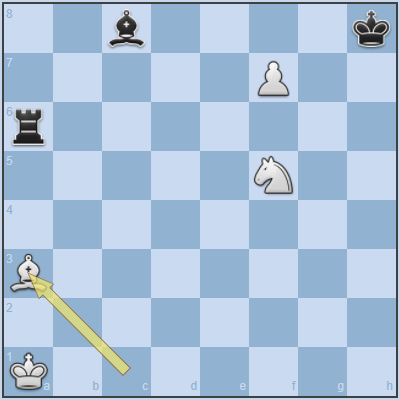
An element of artistic elegance is present in this move, which chess composers call "the unguarded guard". The Ba3 is en prise - it can be taken, and indeed, it is the only chance that black has, as again, Rf6 would be met by Bb2 and an easy win for white. With this move, white is jettisoning half of his forces, remaining with a knight and a pawn!
2....Rxa3+
Now white must step on b2, as Kb1 meets with Bf5+ and Ra8 as already noted.
3.Kb2
I should mention the elegance of the position once again: even here, black cannot reach out to f8 control by playing Rf3, as the Nf5 is in the way. One can see the economy of the construction, which is really an artistic element. Now black has the rook en prise, but he can harass the white king. This can be done in two ways: by checking on b3 and on a2. But 3....Rb3+ is met with 4.Ka2! The white king, by "hiding" behind the black rook, prevents the move 4....Be6+, which would save black as he would be able to win the threatening pawn. So there is only one possibility:
3....Ra2+ (diagram 3)
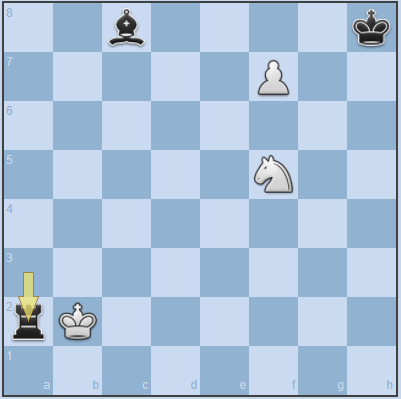
What should white do now? Kb3 is met with Be6+ and the pawn falls. Kc2 or Kb1 are met with Bxf5+ and Ra8, which saves the day. And what if 4.Kc3? To that, black has a cunning reply: 4....Rb2+ 5.Kd4 Rd2+ 6.Ke5 Rd8!, which "sneaks back" into the eight rank beyond the blocking Bc8! Note also that 5.Kb4 (instead of 5.Kd4) would not work for white, as black would continue with 5....Rc4+ 6.Ka5 (e.g.) Rc5+, and then Rxf5 would do the job. So there is only one chance for white:
4.Kc1
Now 4....Rc2+ would not work, as white would replicate the trick of hiding away from bishop checks: 5.Kb1! would leave black defenceless. So black can only check on a1:
4....Ra1+
A fun slow-motion march of the king ensues, for which I will not provide more commentary, as the main themes have been described already above. Note that such a whole-board king march is a very hard thing to justify in an endgame with pieces on the board, and it is an aesthetic element
5.Kd2 Ra2+ (5....Rd1+ would now meet with 6.Kxd1! and white wins) 6.Ke3 Ra3+ 7.Kf4 Ra4+ 8.Kg5 (diagram 4)
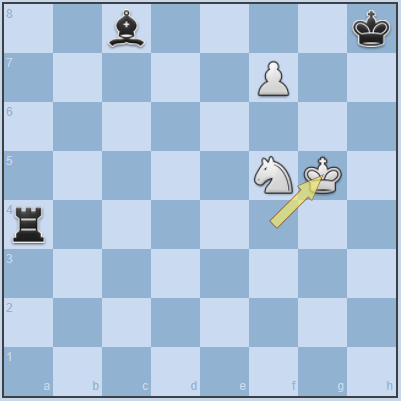
Rg4+!
Note that until now the rook could not check from below, because white would be able to take it. Now the rook is untouchable, though, because 9.Kxg4 is met by the relieving 9....Bxf5+, followed with Kg7 and the pawn will fall.
9.Kh6 Rg8! (diagram 5)
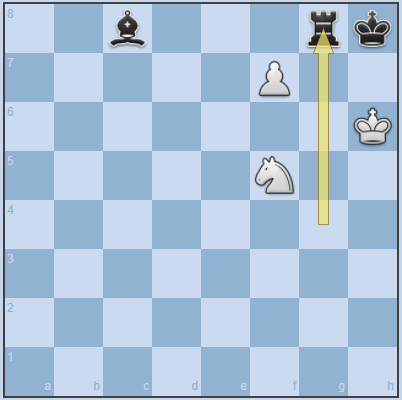
Black has completed his mission - the only way to try and avert immediate defeat: white will not get a new queen. However, the march of the white king has allowed white to occupy a dominant position, and the ending shows how dearly does black pay for it:
10.Ne7!!
This is really a bolt from the blue. Instead of accepting the gift of the black rook, white calmly repositions his knight to a deadly square. Black is now powerless, as fxg8=Q mate is threatened!
10....Be6
This is really the only way to avert immediate mate: black is "x-raying" the f7 pawn. A rook move on the eight rank (e.g., Rf8 or Rd8) instead runs in immediate mate with 11.Ng6++. But now a very beautiful ending appears on the board.
11.fxg8=Q+ Bxg8 12.Ng6 mate!! (diagram 6)
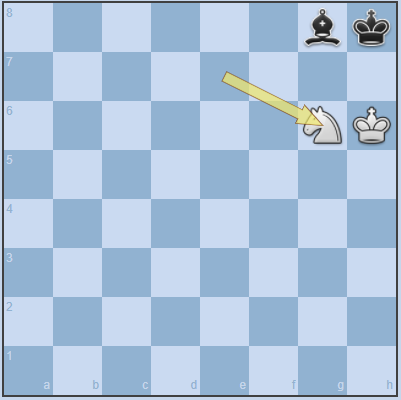
The final position of this study is astonishing in its beauty. With a lone knight white could never mate the black king, unless a bishop blocked the only escape square.
Now, if you have followed the solution to its end you will have to concur that this study presents some clear elements of artistic beauty. But what does this really mean? Its author, Vladimir Korolkov, must have studied for hours to find the exact way to set up the pieces on the initial position such that this miracle would be possible. As I am a chess study composer myself I can sort of understand what he started with: the final position. How to make this position the logical consequence of the attempts of white to win the game and of black to avert that outcome?
Little by little, by retrograde analysis, one can try and consider different possibilities. The whole theme back to move 9 is not too hard to conjure, but making it appear on the board and making it the logical consequence of a long skirmish between rook and king can only be the result of a large amount of hard work.
In the end, what we are looking at, if we stare at the original position, is something that is the result of extensive analysis, injected with deep ideas, brilliant solutions and aesthetic concepts. It is clearly a work of art. But - this is one of a finite number of possible positions on the chess board! In some sense, we would not be wrong if we argued that the position "existed" before Korolkov discovered it!
Does the existence of the position before Korolkov's hard analysis work detract from its artistic value? This is the question I was asking myself above. My personal answer, in hindsight, is clearly "no", as the number of positions that chess can produce is so large that this particular study, this brilliant sequence of moves, could have remained undiscovered forever, even if chess was played for a million years by a billion individuals. It took a Korolkov, his genius, and his art to dig it out. But what does this teach us about art?
I think the issue is not different from that of digging the Pietà out of a block of white marble, which we recognize as an incredible work of art by Michelangelo Buonarroti. Indeed, it has been speculated that the sculptor himself once argued that the sculpture was already in there, trapped and only waiting to be fred by his sapient hand. So this, I guess, only bears on the definition we can give of art. And the point I wish to make here is that this is really great news for artificial intelligence!
Indeed, artificial intelligence has been used to create works of art for a while now - I even gave a public lecture with Giovanni Bianchi on this topic last fall. Many different roads to creating an automated artist have been attempted, but the underlying problem has always been the difficulty for humans to acknowledge the existence of art in the work of an automaton. If we recognize art in a chess study (and by jove, we should), we can well accept that art can exist and be there waiting to be discovered, and that the creativity of the artist can be replaced with the systematic search of a machine.
In fact, I wonder if chess programs today have the capability of systematically searching for beautiful manouvers and aesthetic positions - it would be an interesting byproduct of the development of super-strong chess analysis programs. Indeed, the powerful alphazero neural network developed by Deep Mind produced moves of extraordinary beauty in its latest chess match with another chess machine.
More in general, if we can identify an entirely different way to discover art by the systematic scan of un-artistic material, this bodes really well for art in the forthcoming centuries!
Hat tip: Joshua Haim Mamou, Michael Pasman





Comments